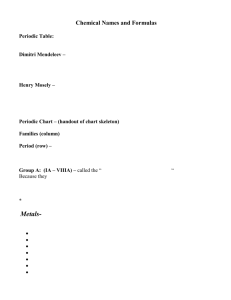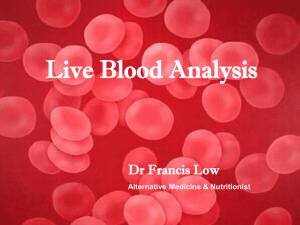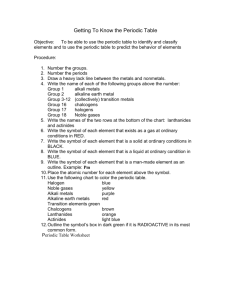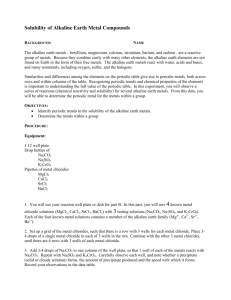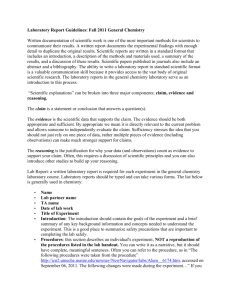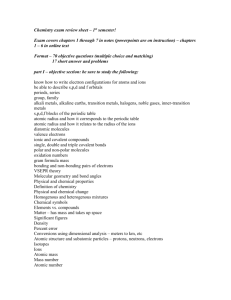Chemistry 1000 Lecture 11: The alkaline earth metals
advertisement
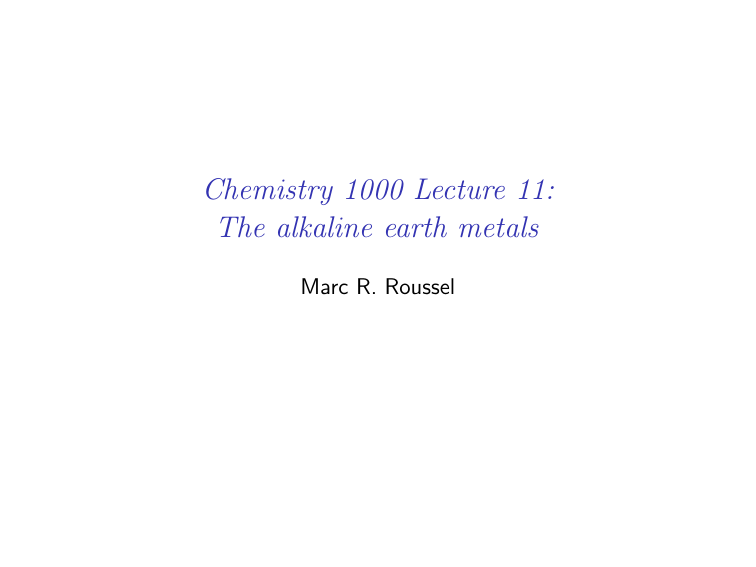
Chemistry 1000 Lecture 11: The alkaline earth metals Marc R. Roussel Group 2: The alkaline earth metals I Group 2, except maybe Be I Soft metals I Form M2+ cations I Very negative reduction potentials: − M2+ (aq) + 2e → M(s) I Be Mg Ca Sr Ba Element E ◦ /V −1.847 −2.356 −2.84 −2.89 −2.92 Relatively small 1st and 2nd ionization energies: Element I1 /kJ mol−1 I2 /kJ mol−1 Be 899.5 1757.1 Mg 737.7 1450.7 Ca 589.8 1145.4 Sr 549.5 1064.2 Ba 502.9 965.2 Ra −2.92 Ra 509.3 979.0 Comparison to alkali metals Physical Properties: Property Mohs hardness Density/g cm−3 Melting point/◦ C Boiling point/◦ C Na 0.5 0.968 97.72 883 Mg 2.5 1.738 650 1090 Chemical properties are often similar to those of the alkali metals, but less reactive: Example: Reaction with water: M(s) + 2H2 O → M(OH)2 + H2(g) =⇒ Often has to be done in hot water or with steam Why “alkaline earth” metals? The name “alkaline earth” was originally applied to the oxides of these metals. Earth is a term applied by early chemists to nonmetallic substances that are insoluble in water and remain stable when heated. The alkaline earth metal oxides have these properties. Alkaline means basic. The alkaline earth metal oxides, to the extent that they dissolve at all in water, make basic solutions: MO(s) + H2 O(l) → M(OH)2 Ionic compounds I Alkaline earth metal compounds tend to be ionic, except for compounds of Be, which displays some peculiar chemistry. I Ionic compounds of the alkaline earth metals with monovalent − anions (e.g. NO− 3 , Cl ) tend to be soluble in water, except hydroxides and fluorides, which are at best slightly soluble. I Ionic compounds of the alkaline earth metals with divalent anions tend to be insoluble (MCO3 , MSO4 ) or only slightly soluble (MS) in water. Flame tests I Since it is possible to precipitate these ions, they are often identified partially by chemical means. I No easy, definitive chemical test to separate these ions from each other I Flame tests used to confirm identity: Ca Sr Element Flame color brick red crimson Be and Mg do not have flame colors. I Ba green Typical reactions of the alkaline earth metals I Reaction with water: M(s) + 2H2 O → M(OH)2 + H2(g) I Reaction with oxygen: 1 M(s) + O2(g) → MO(s) 2 I Reaction with nitrogen: 3M(s) + N2(g) → M3 N2(s) I Reaction with halogens: M(s) + X2 → MX2(s) Example: Synthesis of hydrogen fluoride Hydrogen fluoride is made industrially by reacting calcium fluoride (the mineral fluorspar) with sulfuric acid. What volume of concentrated sulfuric acid (18 M) would be required to completely convert 1 t of calcium fluoride to products? Assuming 100% yield, what mass of hydrogen fluoride would be obtained? Answers: VH2 SO4 = 7 × 102 L, mHF = 5 × 102 kg Carbonates I When heated, alkaline earth carbonates decompose to the corresponding oxide and CO2 : MCO3(s) → MO(s) + CO2(g) I We can regenerate the carbonate in two steps: 1. MO(s) + H2 O(l) → M(OH)2 2. M(OH)2 + CO2(g) → MCO3(s) + H2 O(l) I Reaction with excess acid: 2+ MCO3(s) + 2H+ (aq) → M(aq) + CO2(g) + H2 O(l) Application: Controlling the toxicity of the barium ion I I I I Barium compounds are highly opaque to x-rays, so they could be used as contrast agents for medical imaging. Problem: Ba2+ is highly toxic, probably because it blocks potassium ion channels. If ingested, Ba2+ can be released from barium carbonate when it is combined with stomach acid, leading to life-threatening symptoms. Barium sulfate on the other hand is essentially insoluble, so it is safe to ingest. =⇒ used as a contrast agent in x-ray imaging of the GI tract. Hard water Hard water contains divalent cations, esp. Mg2+ , Ca2+ and Fe2+ Temporary hard water has the counterion HCO− 3 I Called temporary because alkaline earth metal (and other high-valent metal ion) carbonates can be removed by boiling: 2− 2HCO− 3(aq) + heat → CO3(aq) + CO2 + H2 O(l) 2− M2+ (aq) + CO3(aq) → MCO3(s) I If untreated, leads to scale in hot water heaters, pipes, kettles, etc. Note: All water contains a certain amount of bicarbonate because of the equilibrium + CO2(g) + H2 O(l) HCO− 3(aq) + H(aq) Note the production of H+ (aq) . We will see later that carbon dioxide is a Lewis acid. Permanent hard water contains counterions other than bicarbonate (chloride, sulfate, nitrate) whose alkaline earth metal compounds can’t be removed by boiling I Divalent cations tend to precipitate with soaps and detergents =⇒ bathtub ring, greying of clothes I Water can have both temporary and permanent hardness hard water Household water softening: Ion exchange Ca 2+ soft water Na + O − O C + O Na − C O Na + O − O C Beryllium I I Beryllium is weird. Ion r /pm q 11 −3 V /10 C m Li+ 59 1.9 Be2+ 27 39 Mg2+ 72 2.0 Al3+ 53 7.7 High charge density implies a significant ability to attract electrons ∴ Be tends to make covalent bonds instead of ionic compounds Historical diversion I I I Beryllium was discovered by Vauquelin who named it “glucinium”, meaning “sweet tasting” because many of its compounds are sweet. Problem: Beryllium is toxic! The modern name was suggested by Klaproth who confirmed Vauquelin’s discovery. “Beryllium” just refers to the mineral from which it was originally isolated: beryl. Aquamarine Emerald Images from Wikimedia Commons: http://commons.wikimedia.org/wiki/File:Aigue-marine_Pakistan_180308.jpg and http://commons.wikimedia.org/wiki/File:Gachala_Emerald_3526711557_849c4c7367.jpg Chemistry of Be I Forms a thin layer of BeO on contact with air or water. BeO is nonporous, so it prevents further oxidation. This is called passivation. Mg also does this, but none of the other alkaline earth metals do. I BeO doesn’t react with water (so technically Be isn’t an “alkaline earth” metal) I BeF2 and BeCl2 are covalent (molecular) compounds, not ionic Acid/base chemistry of BeO I BeO is amphoteric (both an acid and a base). I Reaction with acid: 2+ BeO(s) + 2 H3 O+ (aq) + H2 O(l) → [Be(OH2 )4 ](aq) I [Be(OH2 )4 ]2+ contains covalent bonds between O and Be. I [Be(OH2 )4 ]2+ is acidic: + + [Be(OH2 )4 ]2+ (aq) + H2 O(l) [Be(OH2 )3 (OH)](aq) + H3 O(aq) I Contrast [Mg(OH2 )6 ]2+ which is not acidic I Reaction with base: 2− BeO(s) + 2 OH− (aq) + H2 O(l) → [Be(OH)4 ](aq) Beryllium halides These are polymers, e.g. BeCl2 : Cl Cl Cl ... Be Be ... Be Cl Cl I Contrast MgCl2 which is ionic Cl Diagonal relationships I The first member of a group is often a bit different. I We typically find that its chemistry is more like that of the chemistry of the second member of the next main group than like that of its own group. Diagonal relationships Example: Li and Mg Li is in many ways more like Mg than like the other alkali metals: I Li is the only alkali metal to form a nitride, whereas this is a typical reaction for the alkaline earth metals. I A number of lithium compounds are much less soluble in water than the corresponding compounds of the other alkali metals (e.g. lithium phosphate). I Li2 CO3 decomposes to Li2 O and CO2 like the alkaline earth metal carbonates, but the other alkali metal carbonates are thermally stable. Diagonal relationships Example: Be and Al We will see that Be behaves a lot like Al: I Both form a tough and chemically resistant passivation layer. I Both have amphoteric oxides. Contrast: basic oxides that define the alkaline earth metals I Their oxides don’t react with water. Contrast: reaction of alkaline earth metals with water to make alkaline earth hydroxides I Both form covalent halides. Contrast: ionic halides of alkaline earth metals (Note: ionic vs covalent character determined from electrical conductivity of melt)


